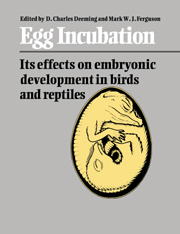Book contents
- Frontmatter
- Contents
- Preface
- Contributors
- 1 Maternal diet, maternal proteins and egg quality
- 2 Comparative composition and utilisation of yolk lipid by embryonic birds and reptiles
- 3 Oviductal proteins and their influence on embryonic development in birds and reptiles
- 4 Fluxes during embryogenesis
- 5 Eggshell structure and formation in eggs of oviparous reptiles
- 6 Shell structure and formation in avian eggs
- 7 Physical characteristics of reptilian eggs and a comparison with avian eggs
- 8 Egg-shape in birds
- 9 The thermal energetics of incubated bird eggs
- 10 Physiological effects of incubation temperature on embryonic development in reptiles and birds
- 11 Cold torpor, diapause, delayed hatching and aestivation in reptiles and birds
- 12 Physical factors affecting the water exchange of buried reptile eggs
- 13 Physiological and ecological importance of water to embryos of oviparous reptiles
- 14 Roles of water in avian eggs
- 15 Water economy and solute regulation of reptilian and avian embryos
- 16 The avian eggshell as a mediating barrier: respiratory gas fluxes and pressures during development
- 17 Gas exchange across reptilian eggshells
- 18 Metabolism and energetics of reptilian and avian embryos
- 19 Reasons for the dichotomy in egg turning in birds and reptiles
- 20 A comparison of reptilian eggs with those of megapode birds
- 21 Why birds lay eggs
- 22 Influences of incubation requirements on the evolution of viviparity
- 23 Overview of early stages of avian and reptilian development
- 24 Ions and ion regulating mechanisms in the developing fowl embryo
- 25 Electrochemical processes during embryonic development
- 26 Methods for shell-less and semi-shell-less culture of avian and reptilian embryos
- 27 Experimental studies on cultured, shell-less fowl embryos: calcium transport, skeletal development, and cardio-vascular functions
- Index
18 - Metabolism and energetics of reptilian and avian embryos
Published online by Cambridge University Press: 16 November 2009
- Frontmatter
- Contents
- Preface
- Contributors
- 1 Maternal diet, maternal proteins and egg quality
- 2 Comparative composition and utilisation of yolk lipid by embryonic birds and reptiles
- 3 Oviductal proteins and their influence on embryonic development in birds and reptiles
- 4 Fluxes during embryogenesis
- 5 Eggshell structure and formation in eggs of oviparous reptiles
- 6 Shell structure and formation in avian eggs
- 7 Physical characteristics of reptilian eggs and a comparison with avian eggs
- 8 Egg-shape in birds
- 9 The thermal energetics of incubated bird eggs
- 10 Physiological effects of incubation temperature on embryonic development in reptiles and birds
- 11 Cold torpor, diapause, delayed hatching and aestivation in reptiles and birds
- 12 Physical factors affecting the water exchange of buried reptile eggs
- 13 Physiological and ecological importance of water to embryos of oviparous reptiles
- 14 Roles of water in avian eggs
- 15 Water economy and solute regulation of reptilian and avian embryos
- 16 The avian eggshell as a mediating barrier: respiratory gas fluxes and pressures during development
- 17 Gas exchange across reptilian eggshells
- 18 Metabolism and energetics of reptilian and avian embryos
- 19 Reasons for the dichotomy in egg turning in birds and reptiles
- 20 A comparison of reptilian eggs with those of megapode birds
- 21 Why birds lay eggs
- 22 Influences of incubation requirements on the evolution of viviparity
- 23 Overview of early stages of avian and reptilian development
- 24 Ions and ion regulating mechanisms in the developing fowl embryo
- 25 Electrochemical processes during embryonic development
- 26 Methods for shell-less and semi-shell-less culture of avian and reptilian embryos
- 27 Experimental studies on cultured, shell-less fowl embryos: calcium transport, skeletal development, and cardio-vascular functions
- Index
Summary
Introduction
Eggs have served as useful model systems for the study of vertebrate growth and energetics of development because they represent a relatively closed system in terms of energy flow. Measurements of growth and energy utilisation can be made easily because, unlike the situation in mammals, the developing embryos are separate from the mother. In addition, metabolic rates of eggs are easy to interpret without the confounding effects of activity, uncontrolled feeding and general stress that are inherent, for instance, in studies of anuran larval development (Feder, 1981). Several reviews are available on the energetics of avian embryos (C. H. Vleck, Vleck & Hoyt, 1980; Bucher & Bartholomew, 1984; Ar et al., 1987; Bucher, 1987; Hoyt, 1987; Vleck & Vleck, 1987). Less information, however, is available for reptile eggs and there are no reviews dealing specifically with reptilian embryonic growth and energetics. Several authors have compared the energetics of development in birds and reptiles (Dmi'el, 1970; Ricklefs & Cullen, 1973; Ackerman, 1980, 1981; Gettinger, Paukstis & Gutzke, 1984) but no recent comparative analysis has been done, despite the growing interest in reptilian egg biology. In this chapter we will discuss the developmental patterns that are evident in bird and reptile eggs. These patterns are compared and an attempt is made to account for them. The problems inherent in making such comparisons between the Classes Reptilia and Aves are discussed.
- Type
- Chapter
- Information
- Egg IncubationIts Effects on Embryonic Development in Birds and Reptiles, pp. 285 - 306Publisher: Cambridge University PressPrint publication year: 1991
- 40
- Cited by



